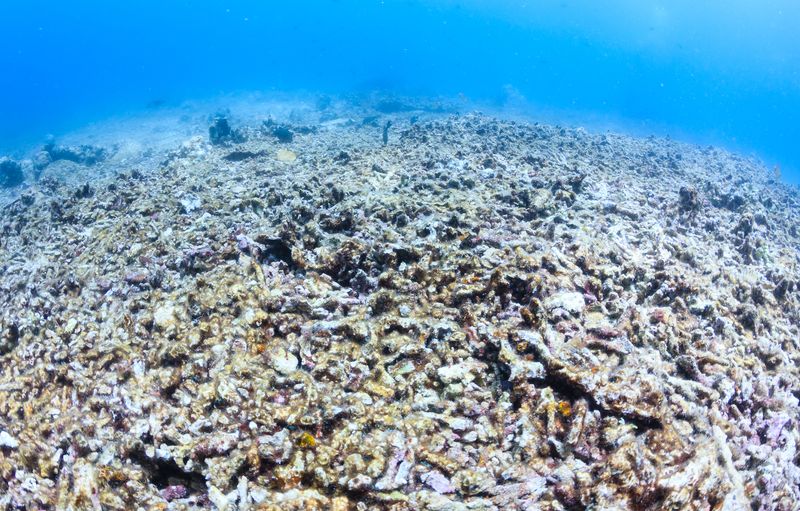We are in dangerous waters. Global temperatures have risen, and this year the world’s oceans have become drastically hotter. However, these marine heatwaves produced by the ongoing climate crisis have coincided with the arrival of a strong El Niño, a team of experts has warned, which may make things even worse. So what can be done to mitigate the potential damage?
Temperatures are rising
Since April this year, average ocean temperatures across the globe have been rising and producing marine heatwaves (MHW), which are more severe than previous years and can last for long periods of time.
In the United Kingdom and Ireland, surface water temperatures in June and July were recorded at 4-5 °C (39.2 to 41 degrees Fahrenheit) warmer than normal for that time of year. In some of the water surrounding Florida, temperatures exceeded 38°C (100.4 degrees Fahrenheit) for the first time in recorded history. These soaring temperatures are being experienced across the tropical Pacific, especially in Japan and off the coast of Peru and Ecuador.
These marine heatwaves pose significant threats to the world’s oceans, as well as important human industries. Rising temperatures are dangerous for many sensitive organisms that live in cool waters, such as kelp and warm water organisms like corals. And the loss of one species can have huge impacts on others. For example, between 2014-15, the West Coast of America experienced “the Blob”: a marine heatwave that killed off many starfish. This led to a sudden surge in the number of sea urchins (a favorite snack for starfish), which then resulted in the loss of kelp forests.
In other instances, marine heatwaves can encourage mobile species to migrate to new places in search of cooler waters.
The impact on marine life also has a significant impact on tourism, fisheries, and aquaculture. The knock-on effects can therefore have severe economic consequences, including job losses, and food scarcity. The proliferation of marine heatwaves can also lead to more harmful algal blooms and other microorganisms that pose a threat to human health.
But these disruptions are also occurring alongside the arrival of El Niño conditions, which will make things far more serious. This has led an international team of experts, in a comment piece in the journal Nature, to call for closer cooperation between decision-makers and those working within “coastal biodiversity conservation, fishing, aquaculture and tourism industries to devise such a strategy for the coming months as well as for the decades ahead”.
Why is El Niño important?
Earlier in June this year, the US National Oceanic and Atmospheric Administration’s (NOAA) Climate Prediction Center announced that El Niño had begun. The phenomenon gets its name (it means “The boy child”) from the fact its characteristic warm waters, which occur around the west coast of South America, reach their peak around Christmas time.
However, even at its start, this year’s El Niño was already causing record temperatures around Peru. This is why an understanding of this meteorological event is important as understanding which regions are most likely to be affected, and gives us time to prepare a response to limit (where possible) its impacts.
The impacts and our preparations
Generally speaking, our knowledge and understanding of marine heatwaves is not on par with that of El Niño, but we have learned a lot since the last one. According to historical data, marine heatwaves are likely to occur in the northeast Pacific, the tropical central-to-eastern Pacific, the waters off eastern Australia, and the Indian Ocean. These areas are among the most susceptible to mass die-offs of marine habitats, especially coral reefs and kelp forests.
Research is also progressing on our ability to predict seawater temperature spikes. In particular, spatial maps used to predict marine heatwaves are more accurate in open water where climate drivers like El Niño are easier to account for than near the coast, where local conditions can impact the results.
But more needs to be done. If local biodiversity conservation, as well as fishing, aquaculture, and tourism industries, are going to manage the coming changes, the experts state in their article, then we need to improve coupled ocean-atmosphere models and assess their predictive abilities.
It is also important for decision-makers to plan local responses to help manage marine heatwaves.
“This year, countries such as Australia and the United States are using seasonal-scale early warning systems,” they write, “with lead times of several months, to provide marine-heatwave briefings to conservation agencies, the fishing and aquaculture industries, and the public.”
Aquaculture industries can prepare for winter/spring heatwaves by ensuring they have a mix of food options for marine stock, such as salmon, and “prepare for disease outbreaks, or change the time of harvest to ensure animals are in prime condition.” In summer and autumn heatwaves, fisheries may need to prepare to close areas off or reduce catch limits so that fish species have a chance to cope with the stress of the heat.
Moreover, the migration of some species seeking cooler water could lead to challenges over jurisdictional management.
The tourism industry should also be prepared for changes. Diving and snorkeling companies may want to reduce the number of staff they have working during the heatwave or shift their activities to limit job losses.
“Whale-watching trips could be increased, for example, as happened off the coast of San Diego, California, during the Blob”, the authors state. “Sports-fishing companies should ensure they have the appropriate permissions, equipment and staffing when warmer-water species move to areas where they are not usually seen.”
For scientists, the team suggests, “researchers should scale up monitoring efforts to characterize a region’s physical and biological conditions before a heatwave’s onset.”
They can deploy sensors to measure key variables – temperature, oxygen, levels, salinity, and the abundance of nutrients in the water – at different scales and at different parts of the ocean (surface and deep waters). Crucially, it is important to establish a baseline for sampled data prior to a heatwave.
Scientists are also being urged to monitor species known to already be living near their temperature limits, as they may serve as early indicators for wider impacts.
The situation is dire. “Worryingly, the climate crisis could eventually cause oceans to reach a permanent heatwave state relative to historical baselines,” the article explains, “and some regions might no longer support certain species and ecosystems. The ecosystems that emerge might not operate and respond to warmer waters in ways that can be anticipated.”
“Regardless of whether a full-blown El Niño event occurs this year, these preparations will aid many marine businesses, because all projections indicate that more-frequent, stronger and longer-lasting marine heatwaves are inevitable in the near future.”
[H/t Nature]




